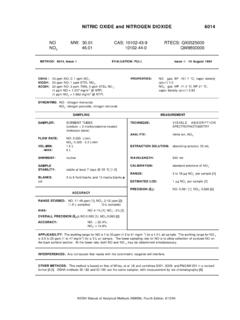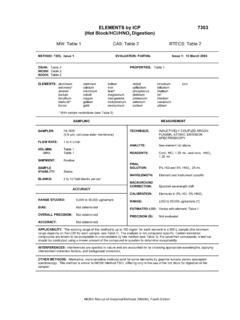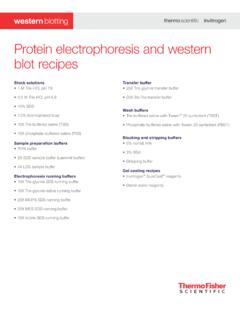Transcription of Particle Size Analysis (Hydrometer Method)
1 DATE: SEPT 2004. Particle Size Analysis (Hydrometer Method). 1. Application The percentage of sand, silt and clay in the inorganic fraction of soil is measured in this procedure. The method is based on Stoke's law governing the rate of sedimentation of particles suspended in water. 2. Summary of Methods The sample is treated with sodium hexametaphosphate to complex Ca++, Al3+, Fe3+, and other cations that bind clay and silt particles into aggregates. Organic matter is suspended in this solution. The density of the soil suspension is determined with a hydrometer calibrated to read in grams of solids per liter after the sand settles out and again after the silt settles. Corrections are made for the density and temperature of the dispersing solution. 3. Safety Each chemical compound should be treated as a potential health hazard. The laboratory is responsible for maintaining a current awareness file of OSHA regulations regarding the safe handling of the chemicals specified in this method.
2 A reference file of material handling data sheets should be made available to all personnel involved in the chemical Analysis . 4. Interferences The principal source of error in this procedure is the incomplete dispersion of soil clays. These clays are cemented by various chemical agents and organic matter into aggregates of larger size. Failure to effect complete dispersion results in low values for clay and high values for silt and sand. The rate of sedimentation also is affected by temperature and the density of the dispersing solution. 5. Apparatus and Materials Glass cylinders, 1000- ml capacity Thermometer, Fahrenheit Hydrometer, Bouyoucos (Fisherbrand Model # 14-331-5c). Electric mixer with dispersing cup Plunger Balance sensitive to 1 Particle Size (Hydrometer). 6. Reagents Dispersing solution, 5%: Dissolve 50 g of sodium hexametaphosphate, Na6 (PO3 )6 in deionized water and dilute to 1 liter. 7. Methods Mix 100 ml of the 5% dispersing solution and 880 ml of deionized water in a 1000 ml cylinder.
3 This mixture is the blank. (Note: 100 ml + 880 ml = 980 ml. This blank is not diluted to 1000 ml; the other 20 ml is the volume occupied by 50 g of soil.). Weigh 25-50 g of soil and transfe r to a dispersing cup. Record weight to Add 100-ml of 5% dispersing solution. Attach dispersing cup to mixer and mix the sample for 30 60 sec. Transfer the suspension quantitatively from the dispersing cup to a 1000. ml cylinder. Fill to the 1000- ml mark with deionized water equilibrated to room temperature, or allow to stand overnight to equilibrate. At the beginning of each set, record the temperature, and the hydrometer reading of the blank, using the procedure described below. To determine the density insert plunger into suspension, and carefully mix for 30. sec. until a uniform suspension is obtained. Remove plunger (begin 40 second timer). and gently insert the hydrometer into the suspension. Record the hydrometer reading at 40 sec. This is the amount of silt plus clay suspended.
4 The sand has settled to the bottom of the cylinder by this time. (Repeat for each sample). Record the hydrometer reading again after 6 hours, 52 minutes. This is the amount of clay in suspension. The silt has settled to the bottom of the cylinder by this time. 8. Calculations Temperature and density corrections: - add unit to the readings of the samples for every 1 F above 67 F, and subtract unit for every 1 F below 67 F. - subtract the density of the blank at each reading, from the corresponding density readings for the samples. Percent clay: % clay = corrected hydrometer reading at 6 hrs, 52 min. x 100/ wt. of sample 2 Particle Size (Hydrometer). Percent silt: % silt = corrected hydrometer reading at 40 sec. x 100/ wt. of sample - % clay Percent sand: % sand = 100% - % silt - % clay 9. Quality Control Standard soil - a standard soil of known Particle size content is analyzed with each batch of samples to check for instrument calibration and procedural accuracy.
5 10. Reporting Results are reported as percentages of the mineral fraction, % sand, % silt, and % clay. Soil texture is based on the USDA textural triangle. (see chart below). 11. References Bouyoucos, 1962. Hydrometer method improved for making Particle size Analysis of soils. Agron. J. 54:464-465. Textural Triangle 3 Particle Size (Hydrometer).



